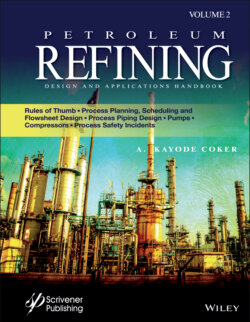Читать книгу Petroleum Refining Design and Applications Handbook - A. Kayode Coker - Страница 44
14.2 Organizational Structure
ОглавлениеThe process design function may be placed in any one of several workable locations in an organization. These locations will be influenced by the primary function of the overall company, i.e., chemical production, engineering, engineering sales, design and manufacture of packaged or specific equipment manufacture, and so on. For best efficiency, regardless of the business nature of the company, the process design being a specialty type operation, works best when specifically identified and given the necessary freedom of contact within and without the company to maintain a high level of practical, yet thorough direction.
A typical working arrangement is shown in Figure 14.1 [1]. In a refinery, consulting or engineering contractor organization, process design and/or process engineering is usually a separate group responsible for developing the process with the customer, or presenting the customer with a turnkey proposed process. In the case of a refinery, the process engineers in various disciplines as the crude distillation and vacuum units, aromatics and reforming units, hydrocracking units, monitor the performance of these units daily and often provide technical information should there be major upsets, mal-operation or a reduction in the performance of these units to the relevant managers who are responsible for overseeing the operation of these units.
In an operating or producing chemical or petrochemical company, the process engineering and design may be situated in a research, technical service, or engineering department. In most cases it is associated with an engineering department if new projects and processes are being planned for the company. If located elsewhere, the designs and planning must be closely coordinated with the engineering activity.
Most current thinking establishes a project team headed by a project engineer or manager to oversee the accomplishment of a given plant development for a process company. If the projects or jobs are small, then the scope of activity is limited and may often be consolidated in a single individual for project and process responsibility. For projects larger than $500,000, the project and process responsibility usually are best kept separate in order to expedite the specific accomplishment of the process design phase. When the process design engineer is required to interpret calculations and specification development and to follow some electrical, structural or even expediting delivery question or problem, the design work cannot be completed at best efficiency and often the quality of process design suffers, assuming there is a fixed target date for completion of the various phases as well as the overall project.
Figure 14.1 A process engineering section supervision chart (Ludwig [1]).
Figure 14.2 Typical organization of “engineering planning team” [2].
Figure 14.2 diagrammatically suggests a team arrangement for accomplishing the planning of a process project. The arrows indicate directions of flow of communications and also the tie-in relationship of the process design function in the accomplishment of an assignment. The planning team in the box works to place the proper perspective on all phases of the engineering functions by developing a working atmosphere of understanding for accomplishing the engineering design. This is physically represented by mechanical vessels, piping, structures, electrical, instrumentation, civil and any other specialized functions. In many projects, the Lead Process Engineer and the Project Lead Engineer are the only individuals who see the details of the overall scope of the project.
